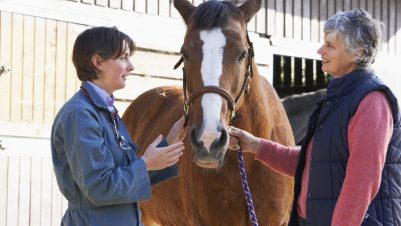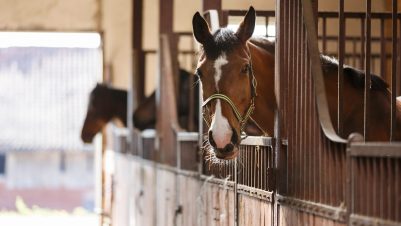Strangles, caused by Streptococcus equi subspecies equi (S. equi), is frequently seen within the equine population, affecting horses of all ages. In most cases, the clinical signs are characterised by acute onset pyrexia, pharyngitis and secondary formation of abscesses within the submandibular and retropharyngeal lymph nodes. Frequently these cases resolve without major complication. In a minority of cases, when the involvement of the retropharyngeal lymph nodes is severe, further clinical signs include respiratory distress, neurological deficits leading to dysphagia and in some cases, fatality.
Clinical disease
S. equi can affect any age of horse but will often be more severe in those that are young due to a lack of innate immunity (although foals can have maternally derived antibodies inferring a degree of immunity).
Pyrexia, often exceeding 42°C (Waller, 2014), occurs 3 to 14 days after exposure to the bacteria, leading to some difficulty in assessing the epidemiological spread of the disease. Following pyrexia, patients can show lymphadenopathy leading to abscesses. These can rupture, leading to large volumes of thick purulent discharge either externally from the site of abscessation or internally into the guttural pouches or pharynx.
Severe cases can have a “simple” obstruction of the pharynx due to the lymphadenopathy, or there can be a neuropraxia leading to dysphagia. Guttural pouch empyema will often occur and should be considered in all cases if persistent nasal discharge occurs (note that S. equi subsp. zooepidemicus should be considered in cases of guttural pouch empyema).
Complications seen with S. equi infections can be as high as 20 percent (Ford and Lokai, 1980) and can include bastard strangles, purpura haemorrhagica, myositis, muscle infarctions, myocarditis and severe respiratory distress and mortality.
Shedding
S. equi shedding usually begins two to three days following the onset of pyrexia and can continue for two to three weeks in most animals. This can be longer when there is persistent infection within the guttural pouch or sinus. Following infection, horses can have an extended immunity to the disease, although this can be overcome if the bacterial challenge is very high (Galán and Timoney, 1985).
Bacterial survival
A recent study presented at the European College of Equine Internal Medicine Congress in 2017 by A Durham showed that during the summer months, S. equi survival appears to be up to seven days in a moist, protected environment, while in the winter, survival in buckets can be as long as 30 days. Thankfully, the bacteria are very sensitive to cleaning and strict biosecurity protocols should reduce the risk of spread.
Diagnosis
Routine blood work can be unrewarding as it will generally show a nonspecific inflammatory profile, which can include a neutrophilia, elevated serum amyloid A and decreased systemic iron.
Culture, though widely available and cheap, can have reduced sensitivity and so should not always be relied upon. This can be due to lack of bacteria on the mucosa in acute cases as they have migrated into the tissue, competition with S. zooepidemicus as these produce zoocins which kill S. equi, or overgrowth by the S. zooepidemicus complicating interpretation. Therefore, culture is often indicated alongside the use of polymerase chain reaction (PCR) rather than alone.
PCR detects partial DNA sequences and will generally have a turnaround the same day of submission, giving quick and useful results. Theoretically, the sample can pick up both dead and live bacteria, but in most cases, this is not clinically significant and the cases should be treated as infectious. Serology, via an enzyme-linked immunosorbent assay, is available and can confirm exposure to the bacteria up to six months later.


The use of serology should be carefully considered and can fulfil the below purposes but will not rule out a carrier animal:
- Comparison of paired titres to indicate current exposure/infection
- To aid in diagnosis of S. equi associated purpura haemorrhagica or bastard strangles
- To attempt to rule out infection prior to travel
The exact choice of test relies on the clinical scenario, but a rough guide should be:
- If there is an external abscess, then a swab for culture and PCR
- If there is nasal discharge, then a pharyngeal wash for PCR
- If there is no overt clinical disease but you are checking for carrier status, then a guttural pouch wash for PCR/culture
- Serology can be used prior to movement to confirm no recent exposure
In the acute phase of the disease, nasopharyngeal washes have been shown to be more sensitive than a nasal swab alone, likely due to the increased surface area accessed during the process (Lindahl et al., 2013). To perform a nasopharyngeal wash, slowly instil 50ml of saline via a 15cm cannula or uterine pipette inserted to the level of the nasal canthus; instil the fluid and collect the washings.
Guttural pouch washes should be performed to rule out carrier status and can be performed by instilling 50ml saline via tubing passed through the biopsy channel of the endoscope and then the fluid collected.
Control
Reducing exposure is the best method of control and therefore quarantine of new animals (for three weeks) and screening prior to arrival is efficacious in reducing the risk of disease.
If an outbreak occurs, it is important to set in place a biosecurity control programme that should include:
- Cessation of movement on or off the yard, which should continue for two weeks beyond resolution of the clinical cases and when all cases are declared S. equi negative
- Implementation of suitable biosecurity, including cleaning of equipment between horses
- Implementation of a traffic light system for horses on the yard:
◽ Red: clinically affected horses should be under strict isolation protocol
◽ Amber: in contact horses should ideally be segregated
◽ Green: no known contact
◽ Temperatures should be taken in the amber and green groups twice daily and if any animals are pyrexic, they should be moved to the red group immediately
- Diagnostic testing to confirm clearance of disease

It has been shown that 10 percent of horses affected in a strangles outbreak can have a failure of guttural pouch drainage and therefore be at risk of carrier status (Newton et al., 1998). To confirm clearance, guttural pouch washes can be started three weeks after resolution of clinical signs and one lavage that is PCR negative confirms clearance of disease. If carrier status is confirmed, treatment with repeated lavage of the guttural pouch and instillation of penicillin is normally curative.
Treatment
The use of antibiotics in clinical cases leaves a clear divide within the industry. The vast majority of cases do not need antibiotics, rather appropriate nursing care.
Cases where antibiotics should be considered include:
- Acutely affected animals with pyrexia and malaise
- Profound lymphadenopathy and subsequent respiratory distress
◽ Horses with lymph node abscessation generally do not require antibiotics as they will be ineffective at penetrating the abscess – instead topical treatment should be instigated to promote abscess maturation
- Bastard strangles and purpura haemorrhagica
Antibiotics should not be used as a preventative. This will increase resistance in the bacterial populations and decrease the immune response. If antibiotics are warranted, penicillin is considered the drug of choice and there is very little evidence of emerging resistance to antibiotics. Trimethoprim-sulfadiazine (TMPS) is generally considered efficacious but does have poor penetration and efficacy in abscesses.
The use of NSAIDs should always be considered as this can improve the horse’s demeanour and increase feed intake.
Conclusions
S. equi infection is normally a mild respiratory disease that has more yard implications than it does for the individual horse. Affected horses should be closely monitored to ensure they do not progress or require intensive therapy, but the mainstay of veterinary involvement includes biosecurity implantation.











